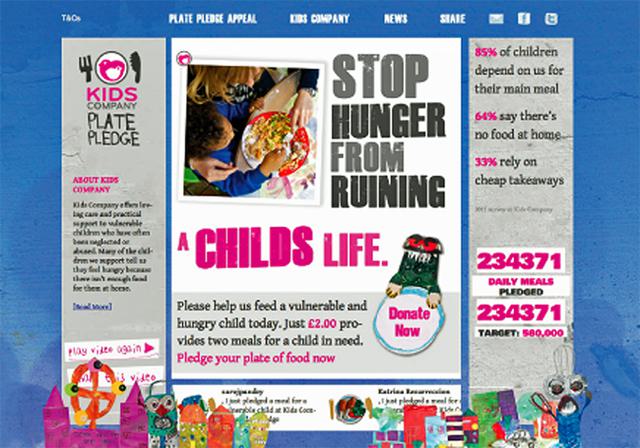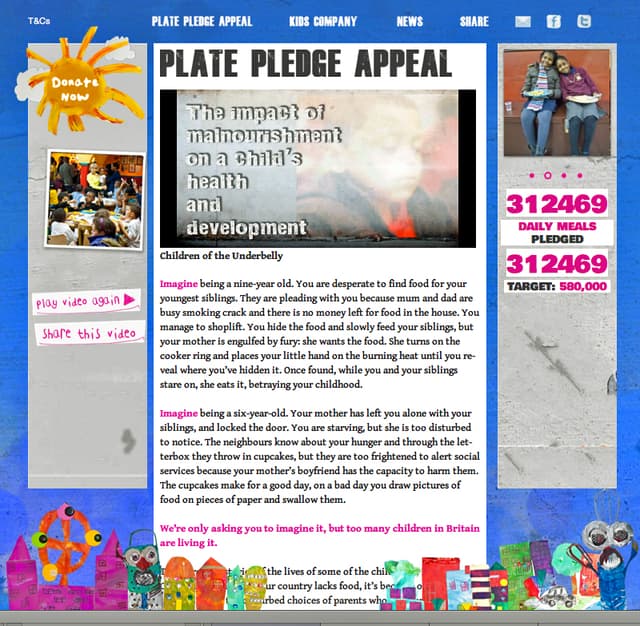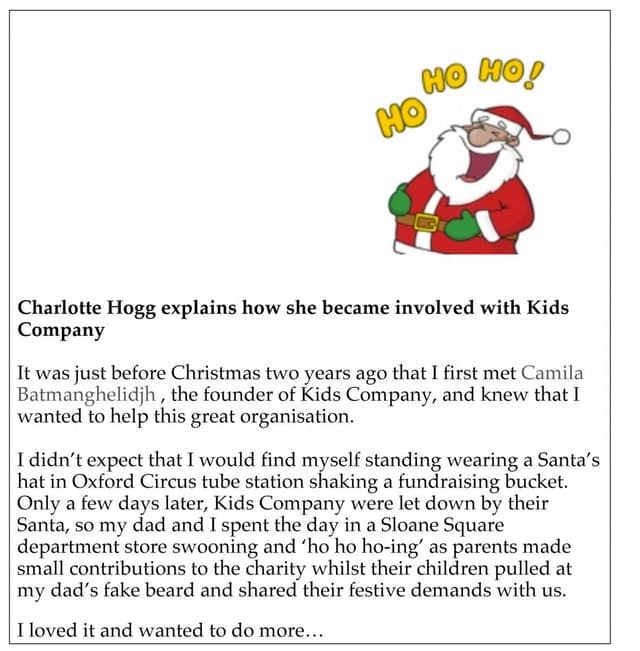Kids Company: the ‘plate pledge’ appeal
- Exhibited by
- Charlotte Hogg, the Rainmaker Foundation
- Added
- February 14, 2013
- Medium of Communication
- Online.
- Target Audience
- Individuals.
- Type of Charity
- Children, youth and family.
- Country of Origin
- UK.
- Date of first appearance
- 2012.
SOFII’s view
This is a really good example of innovative online fundraising. It makes the act of giving easy for the donor, shows them the need and what they can do about it. It also encourages donors to pass the message on to their friends, family and colleagues so that they too can join the ‘plate pledge’ appeal.
Creator / originator
Kids Company and the Rainmaker Foundation.
Summary / objectives
Every day Kids Company offers loving care to vulnerable children who have often been neglected or abused. Many of the children say they feel hungry and that often there just isn’t enough food at home for them. There are an estimated 350,000 children living in severe poverty in London many of whom survive on an inadequate diet.
A survey of children at Kids Company found that:
- 64 per cent reported being hungry because there’s no food in their homes.
- 50 per cent go to bed feeling hungry.
- 33 per cent rely on being given money to eat from a takeaway.
- 85 per cent rely on Kids Company for their main meal of the day.
Kids Company needs to raise more than £1 million a year just to support 2,000 children through their food programme. This covers ingredients, cooks and kitchen support, as well as funding for their food voucher scheme to support children and families who are not able to come to the centres on a daily basis.
Background
After my initial fundraising attempt for Kids Company (see panel story), I wanted to make a bigger contribution to Kids Company so arranged another meeting with Camila Batmanghelidjh, to find how I could most effectively use my experience in launching new businesses, projects and marketing campaigns to benefit Kids Company.
Camila and I discussed her ideas to raise that £1 million each year just to feed the children, which included a gala dinner, a big picnic and a picnic blanket made of paper plates, each of which fed a child for a day and my brain spiralled off into a digital daydream in which I realised that we could feasibly create a virtual ‘plate pledge’ appeal.
Kids Company has some long-term corporate partners, trustees and high net worth donors but hadn’t explored the mass market or digitalised ‘micro donations’.
Although, from an external perspective it seemed that it would be clean and simple to execute a virtual appeal, internally things were much more complicated. The team at Kids Company is large, complex and, then, had varying levels of knowledge, understanding and appetite for risk. The brand is sophisticated and sensitive and the vast majority of staff, management and board were focused on doing and delivering rather than developing strategic planning, knowledge and insight.
There had to be a fundamental shift in thinking to ensure the campaign could work. We needed to change ‘how do our target audience behave?’ to ‘who else could be in our target audience if we behaved differently?’ We needed to shift from ‘word-of-mouth marketing is risky’ to ‘word-of-mouth marketing is powerful’. The team had to understand that high profile, expensive events were not the only way to build strong and long-lasting relationships.
Kids Company had a strong following on social media, they had lots of people engaging in their conversations but were struggling to convert these conversations into cash. Kids Company is a well-known charity but few people realise the huge amount of work they do and there was a need to raise awareness and understanding of the hunger and malnutrition children were facing on the streets of London.
The idea is simple: to create a site that will ultimately become a wall of plates. People are able to make a virtual plate by uploading a photo or logo and then share it on their social channels. Their family, friends and colleagues can either contribute to the plate shared or create their own. The campaign has its own supporters, creates its own PR and Kids Company can offer advertising space on the site to key partners and influencers. The site also has the ability to dedicate a donor’s plate to someone, or add a personal message to encourage people to share and, to add an element of competition, the plates with the most donations rise to the top of the wall of plates.
Special characteristics
The platform provides people with a reason to give. Some charities tend to be very good at sharing their need for funds, but not so good at giving people a reason. The plate pledge appeal gives them that; it also allows people to show that they have done something good and to identify themselves as part of a crowd that is united in their giving. The donation of a virtual plate gives people a sense of pride and allows them to show their social contacts that they have provided a meal for a child.
We spent a lot of time considering the user’s experience of the platform, both online and through mobile phones, to make sure that donors can support the campaign easily and effectively when on the move. It takes just a few clicks for a donor to go from seeing a plate on a friend’s wall and then on to sharing a plate of her own.
Results
The campaign launched with a piece of research into hunger and malnutrition and a double page spread in the Evening Standard. Three months later, without any more significant media coverage to mention, the campaign value sits at just over £400,000.
Merits
It is innovative use of online fundraising. It tells people of the need and why they should make the donation and allows them to do so easily and conveniently.
 View original image
View original image
 View original image
View original image






















